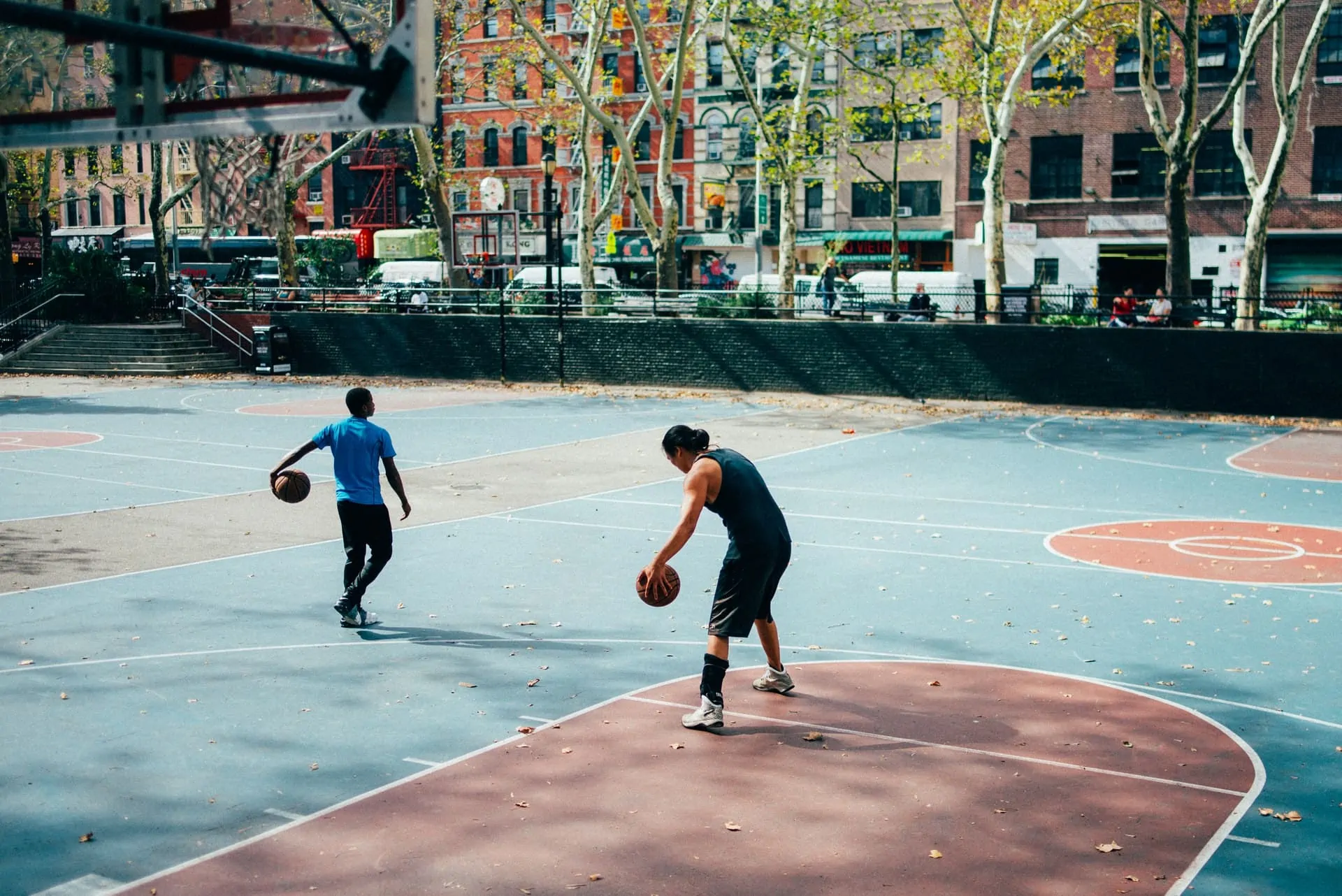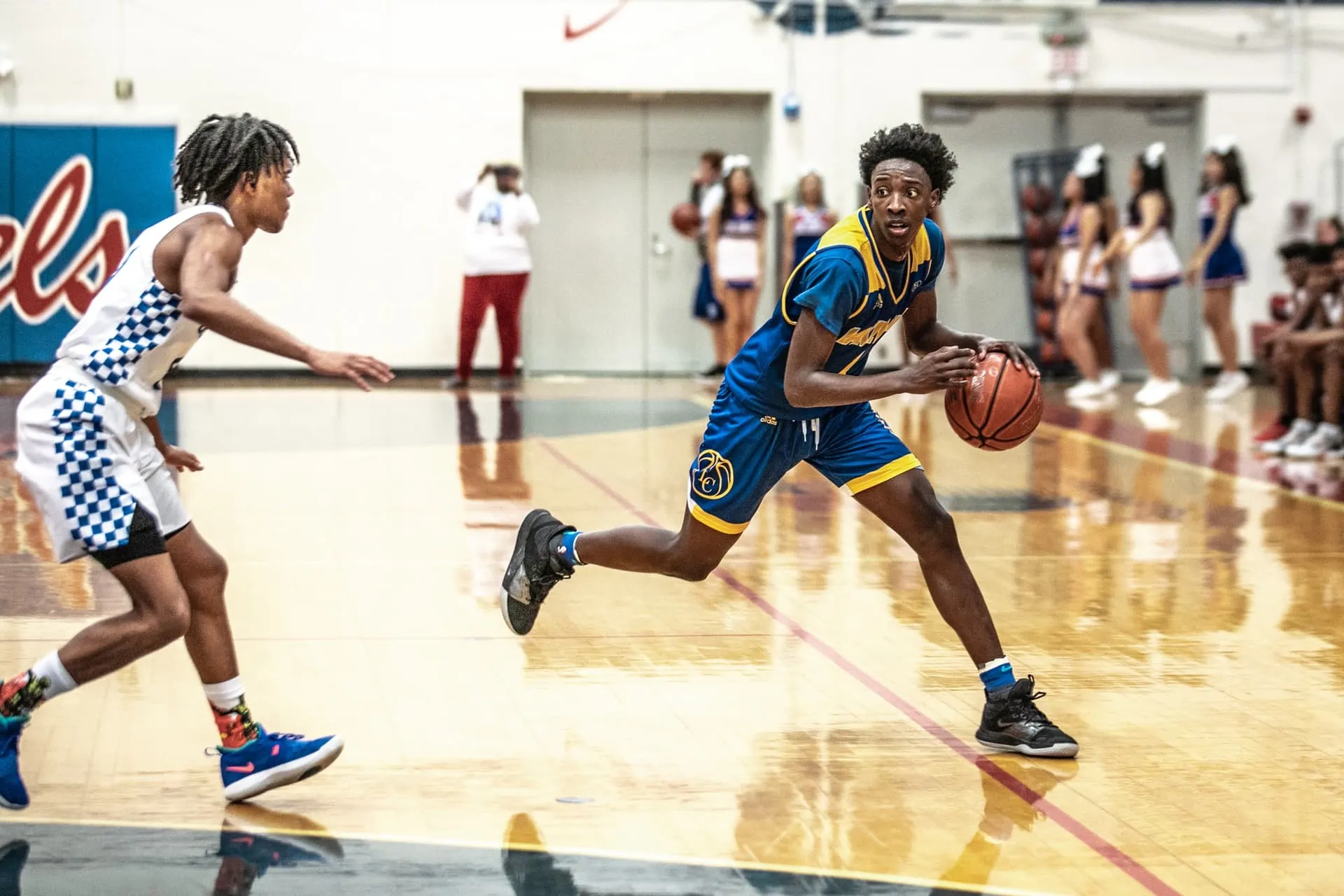So you want to know how to get better handles in basketball? It’s not as difficult as you may think. In this blog post, we will discuss some of the basic steps that you can take to improve your ballhandling skills. We’ll also provide some tips and advice on how to stay motivated and keep practicing. Follow these guidelines, and you’ll be dribbling like a pro in no time!
 What are Handles in Basketball?
What are Handles in Basketball?
First things first, let’s talk about what handles are in basketball. Handles is a skill set that generally refers to a player’s ability to move the ball around the court, including dribbling, passing, catching, and decision-making skills. Strong handles allow a player to maintain control of the ball in high-pressure situations and make quick decisions with the ball.
Many factors contribute to good ballhandling. Some of these include:
Finger Strength – This is important for maintaining control of the ball when dribbling at high speeds or making quick moves.
Wrist Strength – This helps players keep the ball on a string when dribbling and makes it easier to snap off passes.
Court Awareness – Players need to be aware of their surroundings when they have the ball. This skill includes knowing where teammates and defenders are and any obstacles on the court.
 4 Types of Ball Handling
4 Types of Ball Handling
There are four types of ball handling:
Dribbling
Dribbling the ball is the skill that is associated the most with ballhandling. It pertains to the ability of a player to move the ball around the court while maintaining control.
There are a couple of variations of dribbles, depending on the situation. Here they are:
Crossover – Switching one’s dribbling hand from one to another.
Between-the-legs – Bouncing the ball between one’s legs to change dribbling hands. This dribble move is advantageous when defenders are actively trying to swipe the ball.
Behind-the-back – Dribbling behind one’s back to change dribbling hands while protecting the ball. This dribble move may be the only one to be made when the defender is pressuring tightly on one side.
In-and-out – Pretending to perform a crossover or between-the-legs dribble but keeping the ball in the same hand. The goal is to fake out your defender so you can blow past them.
Passing
On the other hand, passing is one of the most overlooked ballhandling skills because it does not involve the player having control of the ball for an extended period. Instead, it involves moving the ball quickly by giving the ball handling duties to someone in a better position to either score or make a play.
However, passing is still a crucial part of ball handling as it helps players keep the ball moving and avoid getting stuck in one place. Many coaches even prefer passing over dribbling because it’s much faster.
There are plenty of variations of passes to choose from. However, here are some of the most basic:
- Chest pass – Often used when both the passer and the intended receiver are both open.
- Bounce pass – When passing lanes are crowded between the passer and receiver, a bounce pass is the best option as the ball’s change in direction can make it difficult for defenders to intercept.
- One-handed pass – When a passer is being pressured on one side, a one-handed pass might be the only possible pass available to him.
- Overhead pass – When a shorter player is defending the passing lanes, an overhead pass might be the most effective way of getting the ball to the receiver where the defender can’t reach it.
Catching
Catching is another important ballhandling skill that often gets overlooked. But, again, this might be because it is not as flashy as dribbling or passing.
However, catching is essential to ensure that passes are received cleanly and securely. It also allows players to take control of the ball quickly after a rebound.
Decision-making
Finally, ball handling also requires good decision-making skills because players need to be able to make split-second decisions on what to do with the ball.
Should they dribble, pass, or shoot? First, players need to assess the situation and quickly make the best decision possible. Without decision-making skills, even the best dribbler and most accurate passer will turn the ball over, especially during crunch time.
Good ballhandling skills are essential for any basketball player. They allow players to keep control of the ball and make quick decisions on the court. By practicing these skills, players can better handle the ball and make plays.
 How Long Does It Take to Get Good Handles in Basketball?
How Long Does It Take to Get Good Handles in Basketball?
How to improve dribbling in basketball and how much time is needed to improve one’s ball handling are questions that we get a lot, and unfortunately, there is no easy answer. It depends on how often you practice, how hard you work, and your natural talents.
But, in general, it can take up to several years to become an exceptional ball handler as it consists of so many different skills. Dribblers, for example, are not necessarily great passers. Decision-making skills, on the other hand, aren’t easily taught through drills. Instead, they come with on-court experience, so do take the time to play in recreational leagues or pick-up games to hone it.
If you are willing to put in the time and effort, you can see significant improvements in your handles in as little as a few weeks with a few choice drills. The key is to practice regularly and focus on improving your weak points.
 Ball Handling vs. Dribbling: What’s the Difference?
Ball Handling vs. Dribbling: What’s the Difference?
Before we dive into how to get better handles in basketball, it’s essential to distinguish between ball handling and dribbling. People often confuse the two terms, but they are pretty different.
Dribbling refers to the act of bouncing the ball on the ground while you move. On the other hand, ball handling is a broader term that refers to how players can control the ball, including dribbling, passing, and even catching.
In other words, dribbling is just one aspect of ball handling. To have great handles, you need to be able to do more than just bounce the ball on the ground.
Now that we’ve cleared that up let’s move on to how you can get better handles in basketball!
 Tips for Proper Ball Handling
Tips for Proper Ball Handling
Here are some tips and advice for how to get better handles in basketball:
- Start by practicing with one hand. Doing so will help you get a feel for the ball and improve your control.
- Practice both hands for dribbling. Gaining proficiency in dribbling with both hands will help players keep the ball under control in whatever direction you’re going on the court.
- Get a feel for the ball by bouncing it off different surfaces such as the ground, walls, and even backboards. Getting familiar with different ways the ball bounces will help players anticipate where the ball will go next.
- Be aware of your surroundings which means knowing where defenders are and predicting their movements. Doing this will help ball handlers avoid turnovers.
- Make sure to practice with various balls, including indoor and outdoor basketballs.
- Be patient. Learning how to dribble, pass, and catch takes time and practice. Don’t get discouraged if you don’t see results immediately.
 5 Ball Handling Drills to Improve Your Game
5 Ball Handling Drills to Improve Your Game
If you’re looking to improve your ball handling, your coach is the best one to ask what drills to practice as they’re the ones who see you every day. They know your strengths and weaknesses, and therefore they’ll know which exercises would benefit you the most.
However, if you want to hone your ball handling skills on your own or with a teammate, we’ve got a couple of drills that might help you here:
1. Figure 8 with Progression
This ball control drill strengthens your fingers and arms as well as improve your feel for the ball.
You will need:
- One Player
- One Ball
Instructions:
- Position the ball suspended between your legs with one hand in front and the other at the back.
- Slowly move the ball from around the player’s leg in a counterclockwise direction mimicking a between-the-legs dribble without letting the ball fall.
- As the ball finishes its orbit around one leg, bring the ball back between the legs and repeat the process on the other leg.
- Maintain this movement for ten repetitions.
- As the player gains confidence, pick up the pace and move the ball quicker.
*Progression – With the ball positioned in between your legs with one hand in front and the other at the back, instead of moving the ball around, you can quickly switch your hand position without ever dropping the ball.
2. Basic 2-Man Passing Drill
This 2-man passing drill will help you work on your communication and court vision.
You will need:
- Two players
- One ball
Instructions:
- One player starts at the top of the key with the ball.
- The other player starts on either baseline.
- On the coach’s signal, the player with the ball will make a pass to the other player.
- The receiving player will then make a return pass.
- After making the return pass, the players will switch roles.
- The passing player must rotate the pass type between chest, bounce, and overhead passes.
- The drill should be continued for a set amount of time or until a certain number of passes are made.
3. High-Low Pound
This 1-man drill can help ball handlers be more comfortable dribbling in crowded lanes.
You will need:
- One player
- One ball
Instructions:
- Start by using pound dribbles at knee height five times as quickly as possible.
- After the five reps of knee-height dribbling, dribble the ball as low as you can only with your wrist.
- Again, do this for five reps.
- After the low dribbles, go back to knee-height pound dribbling but use your opposite hand this time.
- Repeat the entire process going from high to low and then low to high with your opposite hand.
4. Tennis Ball Catch with Progression
Adding a tennis ball into the mix can help improve a player’s dribbling speed as well as their reflexes, coordination, and court vision.
You will need:
- One player
- One tennis ball
Instructions:
- Start by holding the basketball in your right hand and the tennis ball in your left.
- Dribble the basketball as normal with your right hand and try to catch the tennis ball with your left hand as it’s on its way up after each bounce.
- After catching the tennis ball ten times, switch hands and repeat the process.
- You can also incorporate crossovers, behind-the-backs, and in-and-out dribbles as you catch the tennis ball.
*Progression – As you get better at this drill, you can also try bouncing the basketball off a wall and catching the tennis ball on the rebound. Performing this drill should help you develop your coordination even further.
5. 1-Hand Passing Drill
This next drill is designed to help you improve your one-handed passing and catching.
You will need:
- 2 Players
- 2 Balls
Instructions:
- Start by positioning the two players in a bent knee position facing each other.
- Both players will have a ball in their right hand.
- With their right hands, both players will give a lob pass to the player opposite them while catching the other player’s pass simultaneously, similar to a two-person juggling act.
*Progression – to bring the drill to another level, you can turn one side of the exercise into a 1-handed bounce pass instead of a lob.
Wrapping Things Up: How to Get Better Handles in Basketball
Ball handling is a fundamental skill set for basketball players. It’s the primary method of moving the ball around in the hopes of opening up scoring opportunities for the team.
For guards, ball handling is an essential aspect of the game as they’re usually the ones put in charge of bringing the ball up the court and running the offense. For forwards and centers, though, ball handling is also an essential skill as it allows them to facilitate the offense better and make plays for their teammates from the paint.
There are several ways to get better handles in basketball. One is to work on your skills with the ball, such as dribbling and passing. The drills listed above are just some of the most effective ones. Another is to play in games and scrimmages as often as possible, which will help you get a feel for handling the ball under game conditions and practicing your decision-making skills. Finally, it’s crucial to watch film and analyze your own performance to identify areas where you need to improve.
If you can become a master of ball handling, you’ll be one step ahead of the competition on your way to becoming a great basketball player. This way, you’ll have more playing time and the opportunity to showcase your other skills.
Want to get better at basketball?
Join our newsletter & get our comprehensive
101-page basketball guide.
Become a better baller today 👇


 What are Handles in Basketball?
What are Handles in Basketball? 4 Types of Ball Handling
4 Types of Ball Handling 

 How Long Does It Take to Get Good Handles in Basketball?
How Long Does It Take to Get Good Handles in Basketball? Ball Handling vs. Dribbling: What’s the Difference?
Ball Handling vs. Dribbling: What’s the Difference?
 Tips for Proper Ball Handling
Tips for Proper Ball Handling 5 Ball Handling Drills to Improve Your Game
5 Ball Handling Drills to Improve Your Game

